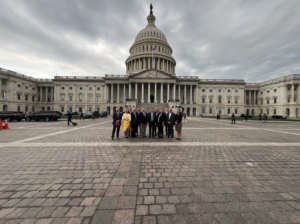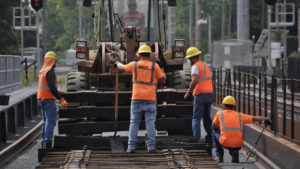Baltimore, CSXT finalize agreement on bridges
Written by jroodFebruary 14, 2001 The Dixon administration is expected to bring two contracts before the Board of Estimates Nov. 18 cementing its two-year-old accord with CSX Transportation under which the railroad will pay roughly three-quarters of the cost of replacing two of the city's most deteriorated bridges, the Baltimore Sun reports.
After years of wrangling, Baltimore
and CSXT reached agreement in principle on the formula for paying for the
replacement of the Fort Avenue and Sinclair Lane bridges in Oct. 2007. But it
has taken two years to work out details. The delay, according to city deputy
transportation director Jamie Kendrick, was the result of "a thousand details
and lots of lawyers, but other than that it was easy."
Under the contracts, which
CSXT has already signed, the railroad will pay 75 percent of the construction
costs and 100 percent of the engineering costs on the Fort Avenue bridge. The
city will contribute the other quarter of the building costs.
That bridge was the subject
of public protests by a Locust Point woman named Karen Johns, who became well-known
in the city as ‘The Bridge Lady." Johns badgered elected officials to put
pressure on CSXT to replace the visibly crumbling bridge, which was built in
1920 and scored 36 points out of 100 – a failing grade — on a recent
inspection.
The same formula will apply
to the construction costs at Sinclair Lane, except that the first $2.3 million
will be covered by a congressional earmark secured by Rep. Elijah Cummings,
D-7th.
The engineering on the
Sinclair Lane bridge has already been completed, and construction is expected
to begin in May or June, Kendrick said. The Nineteenth Century bridge, whose
exact date of construction is unknown, will take 15-18 months to replace. It scored
33 points out 100 on its most recent inspection in 2007.
The Fort Avenue bridge
project, which has yet to go through engineering, is expected to reach its
construction phase in late 2010 or early 2011. Kendrick said the work on the
bridge, on the route to Fort McHenry, will be reopened in time for the
bicentennial of the War of 1812 in May 2012. Until then, visitors to the fort
will have to take a detour.
Kendrick said the city and
CSXT are currently in negotiations over the railroad’s bridge over the tracks
at Sisson Street near Charles Village and one of its crossings of Hanover
Street in South Baltimore. The city and railroad are also discussing a series
of stone arches on the crosstown Belt Line between Charles Village and Harford
Road.
The agreements and the
talks represent a sea change in the once-prickly relationship of the city and
CSXT, which publicly feuded in the aftermath of the 2001 Howard Street Tunnel derailment
and fire.
Kendrick credited a change
in CSXT management’s attitude toward working with local governments.
"This is a whole new
approach to doing things than has been the case for many decades," he said.
Kendrick said Cummings and
former Maryland Transportation Secretary John D. Porcari helped Mayor Sheila
Dixon persuade CSXT to address the bridge issue.





